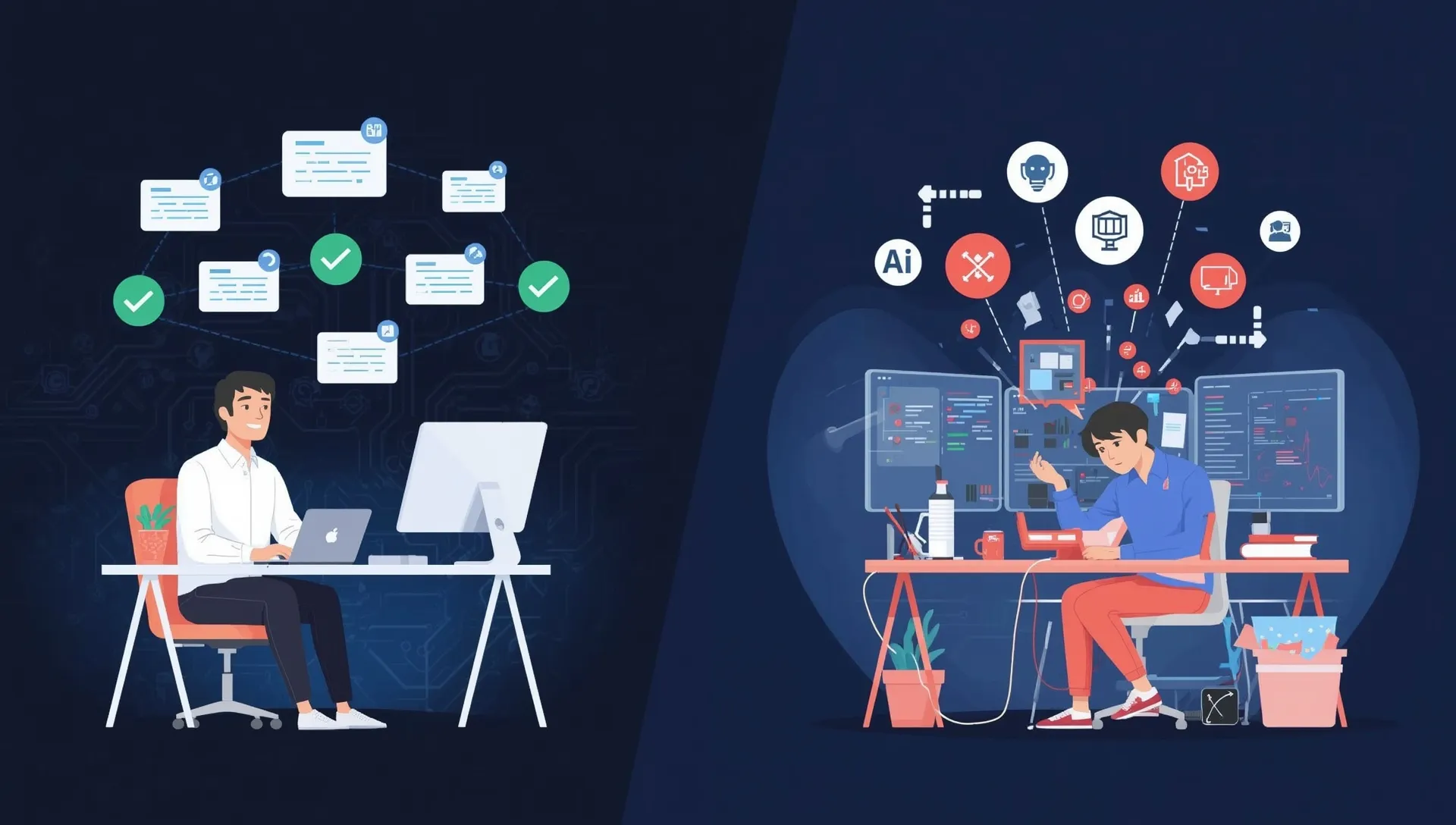
AI coding tools: senior developer superpower or junior developer trap?
AI coding assistants can dramatically accelerate experienced developers, but they're creating a generation of "vibe coders" who can't distinguish good code from disasters. Here's why you need senior technical leadership to harness AI effectively.
Last month, I was called in to review a startup’s codebase after their AI-assisted development team delivered what they proudly called a “revolutionary” e-commerce platform. The founder was ecstatic about the development speed: “We built in three months what would have taken a year!”
The reality was more sobering. The codebase was a 15,000-line monument to every bad practice AI tools can amplify: SQL injection vulnerabilities, hardcoded API keys, memory leaks that would crash the server under normal load, and an authentication system that could be bypassed with a single HTTP header.
The team had used ChatGPT, GitHub Copilot, and various AI code generators extensively. The problem wasn’t the tools themselves. Nobody on the team had the experience to recognize when the AI was producing dangerous nonsense.
This scenario is playing out across the industry. AI coding tools are simultaneously creating superhuman productivity for experienced developers and catastrophic codebases for teams that lack senior technical guidance.
Here’s the uncomfortable truth: AI tools are amplifying the skills gap between senior and junior developers to dangerous proportions. If you’re building a technical product without experienced developers to guide AI usage, you’re not moving fast. You’re building a technical time bomb.
The great AI coding divide: experience makes all the difference
How senior developers use AI tools
Experienced developers approach AI coding tools like expert craftspeople using power tools. They understand the tool’s capabilities, limitations, and when to put it down and work by hand.
Strategic Code Generation: Senior developers use AI to handle boilerplate code, standard implementations, and repetitive patterns. They know what to ask for and can evaluate the output critically.
I watched a senior engineer use GitHub Copilot to generate database migration scripts, review them carefully, adjust for edge cases, and add proper error handling. The AI handled the tedious syntax; the engineer handled the business logic and error scenarios.
Intelligent Research and Documentation: They use AI to research unfamiliar libraries, understand legacy codebases, and generate documentation. But they verify everything and understand the context.
Debugging and Optimization: Senior developers use AI as a rubber duck that can suggest debugging approaches or optimization strategies. They evaluate the suggestions against their understanding of the system.
Pattern Recognition: They leverage AI’s ability to identify patterns in large codebases, but they understand which patterns matter for their specific context.
How AI tools empower senior developers
Velocity Without Compromise: Experienced developers can move 30-50% faster while maintaining quality standards. They use AI to handle mechanical tasks while focusing their expertise on architecture, business logic, and system design.
Exploration and Prototyping: AI tools enable rapid prototyping of different approaches. Senior developers can quickly test multiple solutions and evaluate trade-offs without getting bogged down in implementation details.
Cross-Domain Knowledge: AI helps experienced developers work effectively in unfamiliar domains. A backend expert can use AI assistance to create respectable frontend code, or a Python developer can navigate Rust syntax more effectively.
Facing a leadership challenge right now?
Don't wait for the next fire to burn you out. In a 30-minute discovery call we'll map your blockers and outline next steps you can use immediately with your team.
The wannabe developer trap: when AI becomes a crutch
The “vibe coding” phenomenon
The term “vibe coding” has emerged to describe developers who rely heavily on AI tools without understanding the fundamentals. As originally articulated by Andrej Karpathy, these developers write code based on what “feels right” rather than what actually works correctly.
Vibe coders exhibit these patterns:
Copy-Paste Programming: They take AI-generated code without understanding how it works, what it does, or what could go wrong.
No Error Handling: AI often generates happy-path code. Vibe coders ship it without considering edge cases, error conditions, or failure scenarios.
Security Blindness: They can’t recognize security vulnerabilities because they don’t understand the underlying security principles.
Performance Ignorance: They don’t understand the performance implications of AI-generated code and create applications that work in development but fail under real-world load.
The dangerous amplification effect
AI tools amplify existing capabilities. For senior developers, this means amplified expertise. For inexperienced developers, this means amplified ignorance.
False Confidence: AI tools make it easy to produce code that looks professional but contains fundamental flaws. Junior developers mistake working code for good code.
Reduced Learning: When AI handles the implementation details, junior developers miss opportunities to understand how things actually work.
Technical Debt Acceleration: Poor architectural decisions get implemented quickly and consistently throughout the codebase.
Debugging Paralysis: When AI-generated code fails, developers who don’t understand it can’t fix it effectively.
Real-world disasters from ai-assisted development
Case Study: The Authentication Bypass
A team used AI to implement user authentication for a healthcare application. The generated code looked sophisticated with JWT tokens, password hashing, and proper API endpoints. The problem? The session validation could be bypassed by simply omitting the Authorization header.
A senior developer would have tested the authentication boundary conditions. The junior team trusted that working login meant secure authentication.
Case Study: The Performance Cliff
An e-commerce startup used AI to generate product search functionality. The AI created eloquent database queries that worked perfectly with their 100-product demo dataset. When they launched with 10,000 products, every search took 30+ seconds.
The AI had generated O(n²) algorithms that scaled horribly. An experienced developer would have considered performance from the beginning and tested with realistic data volumes.
Case Study: The Integration Nightmare
A fintech company used multiple AI tools to build different parts of their system. Each component worked individually, but they couldn’t communicate effectively. The AI had made different assumptions about data formats, error handling, and communication protocols.
The result was a system held together by manual data transformations and prayer. Six months later, they spent $200K rewriting everything with consistent architecture principles. Understanding systematic approaches to technical architecture could have prevented this disaster.
Coaching for Tech Leads & CTOs
Ongoing 1:1 coaching for startup leaders who want accountability, proven frameworks, and a partner to help them succeed under pressure.
Why AI makes senior technical leadership even more critical
The quality control problem
AI tools eliminate the natural speed bump that forces developers to think through their implementations. Without experienced oversight, teams ship code faster but with exponentially more problems.
Senior developers and technical leaders provide essential quality control:
Code Review Expertise: They can spot problems that AI tools miss: security vulnerabilities, performance issues, maintainability problems, and architectural misalignment.
Pattern Recognition: They recognize when AI-generated code follows outdated patterns or implements things in ways that will cause problems later.
Business Context: They understand how technical decisions affect business requirements and can guide AI usage toward solutions that actually solve business problems.
The architecture decision challenge
AI tools are excellent at generating code for specific functions but terrible at making system-level architectural decisions. They don’t understand:
- How different components should communicate
- What happens when the system needs to scale
- How to balance performance, security, and maintainability
- When to use existing solutions vs. building custom implementations
Without senior technical guidance, AI-assisted teams create architectures that work in development but fail in production.
The technical debt prevention role
AI tools can quickly implement any approach you describe, whether it’s good or terrible. Senior developers prevent technical debt by:
Evaluating AI Suggestions: They can quickly assess whether AI-generated solutions align with best practices and long-term maintainability.
Providing Context: They help AI tools generate better solutions by providing better prompts that include architectural constraints and business requirements.
Setting Standards: They establish coding standards, architectural principles, and review processes that prevent AI-generated problems from reaching production.
The learning and development need
Teams need senior developers to:
Train Effective AI Usage: Teaching junior developers how to prompt AI tools effectively, evaluate outputs critically, and integrate AI assistance with sound engineering practices.
Provide Context for Generated Code: Explaining why AI generated certain solutions, what the trade-offs are, and when alternative approaches might be better.
Bridge Knowledge Gaps: Helping team members understand the fundamentals that AI tools abstract away.
Got a leadership question?
Share your toughest challenge and I might feature it in an upcoming episode. It's free, anonymous, and you'll get extra resources in return.
The “vibe coding” cleanup: what happens next
When companies rely on junior developers with AI tools, they typically face a painful reckoning 6-12 months later:
The performance crisis
Applications that worked fine in development start failing under real-world load. Database queries that seemed fast with test data become unusably slow. Memory leaks crash servers during peak usage.
The security audit nightmare
When security audits reveal fundamental vulnerabilities throughout the system, companies face expensive security retrofits or complete rebuilds.
The scaling wall
Architectural decisions that seemed reasonable for MVPs prevent the system from scaling. Companies hit walls where adding new features becomes exponentially difficult.
The maintenance nightmare
Code that was quick to write becomes impossible to maintain. Bug fixes introduce new bugs. Simple changes require touching dozens of files. Teams find themselves trapped in technical debt that slows all development.
The “vibe coding fixer” problem
This is where I see many companies make their second mistake: hiring a “senior developer” to fix their AI-generated codebase without understanding what they actually need.
They often hire someone who claims senior experience but lacks the deep architectural thinking and system design skills needed to clean up AI-amplified disasters. These “vibe coding fixers” often make the problems worse by adding more complexity without addressing fundamental architectural issues.
What you actually need: fractional CTO or senior technical leadership
For non-technical founders
If you’re a non-technical founder using AI tools to build your product, you need senior technical guidance more than ever. The speed at which AI can generate bad code makes technical oversight critical from day one.
Non-technical founders face unique challenges that AI tools amplify rather than solve:
Technical Decision Making: AI tools make it easy to implement any technical approach, but you need someone who understands which approaches align with your business needs.
Quality Assurance: You need someone who can distinguish between code that works and code that works reliably at scale.
Risk Assessment: AI-generated code can introduce security, performance, and architectural risks that aren’t obvious until they cause problems.
A Fractional CTO can provide this oversight without the cost of full-time senior technical leadership.
For technical teams
Even teams with some technical experience benefit from senior leadership when using AI tools extensively:
Code Review Standards: Establishing review processes that catch AI-generated problems before they reach production.
Architecture Guidelines: Creating principles that guide AI usage toward maintainable, scalable solutions.
Team Development: Teaching effective AI usage alongside fundamental engineering skills so team members grow rather than becoming dependent on AI crutches.
For growing companies
As companies scale, the costs of AI-amplified technical debt compound. Senior technical leadership helps by:
Preventing Technical Debt: Establishing practices that prevent AI from creating long-term maintenance problems.
Building Technical Capabilities: Developing team members who can use AI effectively while understanding the fundamentals.
Strategic Technology Planning: Ensuring AI usage aligns with long-term technical and business strategy.
Best practices: harnessing AI tools responsibly
For senior developers and technical leaders
Establish AI Usage Guidelines: Create clear standards for when and how to use AI tools. Include requirements for review, testing, and documentation of AI-generated code.
Implement Rigorous Code Review: Focus code reviews on areas where AI commonly fails: security, performance, error handling, and architectural alignment.
Maintain Testing Standards: Ensure AI-generated code meets the same testing requirements as hand-written code. AI often generates code that passes simple tests but fails edge cases.
Document AI Assistance: Track which code was AI-generated so future maintainers understand what they’re working with.
For teams using AI tools
Always Review and Understand: Never ship AI-generated code without understanding what it does and why it works that way.
Test Edge Cases: AI typically generates happy-path code. Test error conditions, boundary cases, and failure scenarios.
Consider Performance and Security: Evaluate AI-generated code for performance implications and security vulnerabilities.
Maintain Learning: Use AI as a productivity tool, not a replacement for understanding. Keep developing fundamental skills.
For organizations
Invest in Senior Technical Talent: The productivity gains from AI tools are only valuable if you can harness them safely. This requires experienced technical leadership.
Establish Technical Standards: Create architectural principles, coding standards, and review processes that apply regardless of whether code is AI-generated or hand-written.
Build Review Processes: Implement systematic reviews that catch problems before they reach production.
Plan for Long-term Maintenance: Consider how AI-generated code will be maintained, debugged, and enhanced over time.
Coaching for Tech Leads & CTOs
Ongoing 1:1 coaching for startup leaders who want accountability, proven frameworks, and a partner to help them succeed under pressure.
The strategic implications: AI tools and competitive advantage
The widening skills gap
AI tools are creating a widening gap between organizations with strong technical leadership and those without:
Teams with Senior Guidance: Use AI to accelerate development while maintaining quality standards. They build faster, more reliably, and create sustainable competitive advantages.
Teams Without Guidance: Create technical debt faster than ever before. They may initially appear to move quickly, but they hit scaling walls and maintenance crises that slow all future development.
The hiring challenge
The prevalence of AI tools is making it harder to evaluate technical talent. Candidates can use AI assistance during interviews and coding challenges, making it difficult to assess their actual capabilities.
This makes effective senior engineer hiring practices even more critical. You need interview processes that evaluate system thinking, architectural decision-making, and the ability to evaluate and improve AI-generated code.
The long-term technical strategy
Organizations need to develop AI strategies that consider:
Technical Debt Management: How to prevent AI usage from creating unsustainable technical debt.
Team Development: How to use AI tools while ensuring team members continue developing fundamental skills.
Quality Assurance: How to maintain quality standards when development velocity increases dramatically.
Competitive Positioning: How to use AI tools to create sustainable competitive advantages rather than short-term speed.
The path forward: building AI-enhanced technical teams
For startups and growing companies
Start with Senior Leadership: Before scaling AI-assisted development, establish senior technical leadership that can guide effective AI usage and prevent common pitfalls.
Establish Standards Early: Create technical standards, review processes, and quality gates that apply to all code, regardless of origin.
Invest in Team Development: Ensure team members understand the fundamentals that AI abstracts away. This enables better AI usage and reduces dependency.
Plan for Scale: Make architectural decisions that support both current AI-assisted productivity and future scaling needs.
For established organizations
Audit AI Usage: Review existing AI-assisted code for security vulnerabilities, performance problems, and architectural issues.
Establish Governance: Create policies and processes for AI tool usage that balance productivity with quality and security.
Develop Internal Expertise: Train teams to use AI tools effectively while maintaining engineering fundamentals.
Strategic Integration: Integrate AI tools into development processes in ways that enhance rather than replace human expertise.
Conclusion: the senior developer advantage in the AI era
AI coding tools are not inherently good or bad. They’re amplifiers that enhance the capabilities of experienced developers and the mistakes of inexperienced ones.
The companies that thrive in the AI era will be those that combine the productivity benefits of AI tools with the wisdom and experience of senior technical leadership. They’ll move faster than competitors while building more reliable, secure, and maintainable systems.
The companies that struggle will be those that mistake AI-generated code for AI-guided technical strategy. They’ll create impressive demos and then spend months or years dealing with the consequences of AI-amplified technical debt.
Key takeaways
For Non-Technical Founders: AI tools make senior technical guidance more important, not less. The speed at which you can generate bad technical decisions requires experienced oversight from the beginning.
For Technical Teams: AI tools are most valuable when guided by senior developers who can evaluate outputs, provide context, and ensure alignment with best practices.
For Senior Developers: AI tools represent a significant competitive advantage when used thoughtfully. They enable you to work at unprecedented speed while maintaining the quality standards that separate good code from disasters.
For Organizations: The ROI of AI tools depends entirely on having the technical expertise to use them effectively. Invest in senior technical leadership before scaling AI-assisted development.
The investment that pays for itself
The cost of senior technical guidance, whether through full-time hires or fractional leadership, pales in comparison to the cost of cleaning up AI-generated technical disasters.
I’ve seen companies spend 6-18 months and hundreds of thousands of dollars fixing codebases that could have been built correctly the first time with proper technical oversight.
The question isn’t whether you can afford senior technical leadership. It’s whether you can afford to build your technical foundation without it.
AI tools have the potential to democratize software development, but only for teams that understand how to use them wisely. Don’t let the impressive capabilities of AI tools fool you into thinking they replace the need for technical expertise. They make that expertise more valuable than ever.
Facing a leadership challenge right now?
Don't wait for the next fire to burn you out. In a 30-minute discovery call we'll map your blockers and outline next steps you can use immediately with your team.
I’ve helped dozens of organizations navigate the challenges of AI-assisted development, from preventing technical disasters to building sustainable AI-enhanced development practices. If you’re looking to harness the power of AI tools while maintaining technical quality and avoiding common pitfalls, I’d be happy to discuss how fractional CTO support can help your specific situation.
📈 Join 2,000+ Tech Leaders
Get my weekly leadership insights delivered every Tuesday. Team scaling tactics, hiring frameworks, and real wins from the trenches.
Related Articles

Surviving a key developer departure: business continuity planning
When your most critical engineer gives notice, you have 2-4 weeks to prevent business catastrophe. After helping dozens of companies navigate key person departures, here's the systematic approach to knowledge transfer and team resilience that can save your startup.

Managing technical risk during rapid growth: what keeps CTOs awake
Rapid business growth creates technical risks that can destroy companies overnight. After helping dozens of fast-growing startups navigate hypergrowth, here's how to identify, prioritize, and manage technical risk without killing momentum.

Technical due diligence red flags every investor should know
Avoid costly technical surprises in your startup investments. Learn the critical red flags and warning signs that experienced investors look for during technical due diligence, with practical frameworks for evaluating engineering teams, architecture decisions, and technical debt risks.
